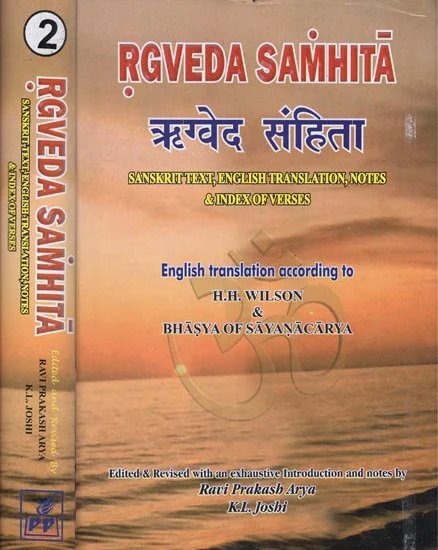Rig Veda (translation and commentary)
by H. H. Wilson | 1866 | 1,999,864 words | ISBN-10: 8171101380 | ISBN-13: 9788171101382
The Rig-Veda, English translation, including the commentary of Sayana and grammatical analysis. The hyms of the Rigveda Samhita represents some of the oldest and complex of Hindu Sanskrit literature. In ten books, these mantras form the core essence of rituals and ceremonies once widely performed throughout ancient India. This edition contains the...
Disclaimer: These are translations of Sanskrit texts and are not necessarily approved by everyone associated with the traditions connected to these texts. Consult the source and original scripture in case of doubt.
Rig Veda 1.22.17
Sanskrit text [Accents, Plain, Transliterated]:
इ॒दं विष्णु॒र्वि च॑क्रमे त्रे॒धा नि द॑धे प॒दम् । समू॑ळ्हमस्य पांसु॒रे ॥
इदं विष्णुर्वि चक्रमे त्रेधा नि दधे पदम् । समूळ्हमस्य पांसुरे ॥
idaṃ viṣṇur vi cakrame tredhā ni dadhe padam | samūḻham asya pāṃsure ||
English translation:
“Viṣṇu traversed this (world); three times he plural nted his foot and the whole (world) was collected in the dust of his (footstep).”
Commentary by Sāyaṇa: Ṛgveda-bhāṣya
Tredhā nidhadhe padam: the three paces of Viṣṇu imply the presence of Viṣṇu in the three regions of earth, air and heaven, in the forms of Agni, Vāyu and Sūrya, fire, wind and the sun. According to Śākapūṇi, the step was on earth, in the firmament, in heaven; according to Aurṇavābha on Samārohaṇa or the eastern mountain, on Viṣṇupada the meridian sky and Gayaśiras the western mountain, thus identifiying Viṣṇu with the Sun, and his three paces with the rise, culmination, and setting of that luminary
Details:
Ṛṣi (sage/seer): medhātithiḥ kāṇvaḥ [medhātithi kāṇva];Devatā (deity/subject-matter): viṣṇuḥ ;
Chandas (meter): pipīlikāmadhyānicṛdgāyatrī;;
Svara (tone/note): Swar;
Padapatha [Accents, Plain, Transliterated]:
इ॒दम् । विष्णुः॑ । वि । च॒क्र॒मे॒ । त्रे॒धा । नि । द॒धे॒ । प॒दम् । सम्ऽऊ॑ळ्हम् । अ॒स्य॒ । पां॒सु॒रे ॥
इदम् । विष्णुः । वि । चक्रमे । त्रेधा । नि । दधे । पदम् । सम्ऊळ्हम् । अस्य । पांसुरे ॥
idam | viṣṇuḥ | vi | cakrame | tredhā | ni | dadhe | padam | sam-ūḷham | asya | pāṃsure
Multi-layer Annotation of the Ṛgveda
[Rigveda 1.22.17 English analysis of grammar]
[noun], accusative, singular, neuter
“this; he,she,it (pers. pron.); here.”
[noun], nominative, singular, masculine
“Vishnu; Krishna; Viṣṇu; Om; Shiva.”
[adverb]
“apart; away; away.”
[verb], singular, Perfect indicative
“kram; step; go; continue; proceed; traverse; heat.”
[adverb]
“threefold.”
[adverb]
“back; down.”
[verb], singular, Perfect indicative
“put; give; cause; get; hold; make; provide; lend; wear; install; have; enter (a state); supply; hold; take; show.”
[noun], accusative, singular, neuter
“word; location; foot; footprint; pada [word]; verse; footstep; metrical foot; situation; dwelling; state; step; mark; position; trace; construction; animal foot; way; moment; social station; topographic point; path; residence; site; topic.”
[verb noun], nominative, singular
“massage.”
[noun], genitive, singular, masculine
“this; he,she,it (pers. pron.); here.”
[noun], locative, singular, neuter
